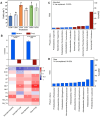The process of nitrogen-adaptation root endophytic bacterial rather than phosphorus-adaptation fungal subcommunities construction unveiled the tomato yield improvement under long-term fertilization
- PMID: 39895939
- PMCID: PMC11782164
- DOI: 10.3389/fmicb.2024.1487323
The process of nitrogen-adaptation root endophytic bacterial rather than phosphorus-adaptation fungal subcommunities construction unveiled the tomato yield improvement under long-term fertilization
Abstract
Interactions between endophytes (endophytic bacteria and fungi) and plants are crucial in maintaining crop fitness in agricultural systems, particularly in relation to abundant and rare subcommunities involved in community construction. However, the influence of long-term fertilization on heterogeneous rhizosphere nitrogen and phosphorus environments and how these conditions affect the key subcommunities of root endophytes and their community assembly mechanisms remain unclear. We studied the 26th year of a field experiment conducted in a greenhouse with varying levels of nitrogen and phosphorus (CKP0, CKP1, CNP0, CNP1, ONP0, and ONP1) to assess the composition of tomato root endophytes and their impact on yield. We employed 16S rRNA and fungal ITS region amplicon sequencing to investigate the assembly mechanisms of abundant and rare endophytic subcommunities, network correlations, core subcommunity structures, and key species that enhance crop yield. The results indicated that organic manure and phosphorus fertilizers significantly increased the rhizosphere soil nitrogen content, phosphorus content, and phosphorus availability (labile P, moderately labile P, and non-labile P). These fertilizers also significantly affected the composition (based on Bray-Curtis distance) and community assembly processes (βNTI) of endophytic microbial subcommunities. The assembly of both bacterial and fungal subcommunities was primarily governed by dispersal limitation, with community structures being significantly regulated by the content of rhizosphere soil available nitrogen (AN) and moderately labile P (MLP). Rare bacterial and fungal subcommunities complemented the ecological niches of abundant subcommunities in the co-occurrence network, supporting community functions and enhancing network stability. Nitrogen-adapting abundant and rare bacterial subcommunities provided a stronger predictive correlation for tomato yield than phosphorus-adapting fungal subcommunities. Additionally, three core genera of rare endophytic bacteria such as Arthrobacter, Microbacterium, and Sphingobium were identified as potentially involved in improving crop yield improvement. These findings revealed the distinct assembly mechanisms of endophytic microbial subcommunities affected by fertilization, enhancing our understanding of better management practices and controlling endophytes to improve crop yield in intensive agricultural ecosystems.
Keywords: abundant microbial taxa; community assembly; endophyte; rare microbial taxa; solar greenhouse.
Copyright © 2025 Li, Awais, Wang, Zhang, Zhao, Liu, Sun, Fu and Li.
Conflict of interest statement
The authors declare that the research was conducted in the absence of any commercial or financial relationships that could be construed as a potential conflict of interest.
Figures







Similar articles
-
Abundant bacterial subcommunity is structured by a stochastic process in an agricultural system with P fertilizer inputs.Sci Total Environ. 2023 May 1;871:162178. doi: 10.1016/j.scitotenv.2023.162178. Epub 2023 Feb 11. Sci Total Environ. 2023. PMID: 36775144
-
Long-term application of nitrogen and phosphorus fertilizers changes the process of community construction by affecting keystone species of crop rhizosphere microorganisms.Sci Total Environ. 2023 Nov 1;897:165239. doi: 10.1016/j.scitotenv.2023.165239. Epub 2023 Jun 30. Sci Total Environ. 2023. PMID: 37394065
-
Response of abundant and rare microbial species to 40-year long-term fertilization practices irrespective of bulk and rhizosphere soils.Environ Res. 2025 Jun 15;275:121448. doi: 10.1016/j.envres.2025.121448. Epub 2025 Mar 20. Environ Res. 2025. PMID: 40120738
-
Root stoichiometry explains wheat endophytes and their link with crop production after four decades of fertilization.Sci Total Environ. 2022 Nov 10;846:157407. doi: 10.1016/j.scitotenv.2022.157407. Epub 2022 Jul 16. Sci Total Environ. 2022. PMID: 35850352
-
Abundant and rare soil fungi exhibit distinct succession patterns in the forefield of Dongkemadi glacier on the central Qinghai-Tibet Plateau.Sci Total Environ. 2022 Jul 1;828:154563. doi: 10.1016/j.scitotenv.2022.154563. Epub 2022 Mar 14. Sci Total Environ. 2022. PMID: 35302033
Cited by
-
Endophytic Fungal Diversity and Its Interaction Mechanism with Medicinal Plants.Molecules. 2025 Feb 24;30(5):1028. doi: 10.3390/molecules30051028. Molecules. 2025. PMID: 40076252 Free PMC article. Review.
References
-
- Adeleke B. S., Babalola O. O., Glick B. R. (2021). Plant growth-promoting root-colonizing bacterial endophytes. Rhizosphere 20:100433. doi: 10.1016/j.rhisph.2021.100433 - DOI
-
- Almario J., Jeena G., Wunder J., Langen G., Zuccaro A., Coupland G., et al. . (2017). Root-associated fungal microbiota of nonmycorrhizal Arabis alpina and its contribution to plant phosphorus nutrition. Proc. Natl. Acad. Sci. USA 114, E9403–e9412. doi: 10.1073/pnas.1710455114, PMID: - DOI - PMC - PubMed
-
- Bai L., Zhang X., Li B., Sun F., Zhao X., Wang Y., et al. . (2022). Fungal communities are more sensitive to nitrogen fertilization than bacteria in different spatial structures of silage maize under short-term nitrogen fertilization. Appl. Soil Ecol. 170:104275. doi: 10.1016/j.apsoil.2021.104275 - DOI
LinkOut - more resources
Full Text Sources

